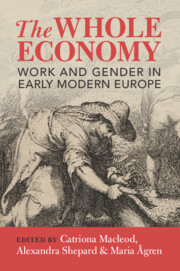Refine search
Actions for selected content:
26945 results in Economic history
Index
-
- Book:
- Order and Rivalry
- Published online:
- 01 June 2023
- Print publication:
- 15 June 2023, pp 310-322
-
- Chapter
- Export citation
7 - The International Chamber of Commerce and the Politics of Business
-
- Book:
- Order and Rivalry
- Published online:
- 01 June 2023
- Print publication:
- 15 June 2023, pp 223-258
-
- Chapter
- Export citation
6 - European Unity and Security
-
- Book:
- Order and Rivalry
- Published online:
- 01 June 2023
- Print publication:
- 15 June 2023, pp 185-222
-
- Chapter
- Export citation
Preface
-
- Book:
- The Whole Economy
- Published online:
- 09 June 2023
- Print publication:
- 15 June 2023, pp ix-x
-
- Chapter
- Export citation
Contents
-
- Book:
- The Whole Economy
- Published online:
- 09 June 2023
- Print publication:
- 15 June 2023, pp v-v
-
- Chapter
- Export citation
Contents
-
- Book:
- Order and Rivalry
- Published online:
- 01 June 2023
- Print publication:
- 15 June 2023, pp vii-vii
-
- Chapter
- Export citation
1 - Households
-
-
- Book:
- The Whole Economy
- Published online:
- 09 June 2023
- Print publication:
- 15 June 2023, pp 26-52
-
- Chapter
- Export citation
Dedication
-
- Book:
- Order and Rivalry
- Published online:
- 01 June 2023
- Print publication:
- 15 June 2023, pp v-vi
-
- Chapter
- Export citation
Introduction
-
-
- Book:
- The Whole Economy
- Published online:
- 09 June 2023
- Print publication:
- 15 June 2023, pp 1-25
-
- Chapter
- Export citation
2 - Care
-
-
- Book:
- The Whole Economy
- Published online:
- 09 June 2023
- Print publication:
- 15 June 2023, pp 53-83
-
- Chapter
- Export citation
Copyright page
-
- Book:
- Order and Rivalry
- Published online:
- 01 June 2023
- Print publication:
- 15 June 2023, pp iv-iv
-
- Chapter
- Export citation

The Whole Economy
- Work and Gender in Early Modern Europe
-
- Published online:
- 09 June 2023
- Print publication:
- 15 June 2023
FHR volume 30 issue 1 Cover and Back matter
-
- Journal:
- Financial History Review / Volume 30 / Issue 1 / April 2023
- Published online by Cambridge University Press:
- 08 June 2023, pp. b1-b2
-
- Article
-
- You have access
- Export citation
6 - Sending Ships to China to Finance Monastery Construction
-
- Book:
- Networks of Faith and Profit
- Published online:
- 25 May 2023
- Print publication:
- 08 June 2023, pp 128-163
-
- Chapter
- Export citation
FHR volume 30 issue 1 Cover and Front matter
-
- Journal:
- Financial History Review / Volume 30 / Issue 1 / April 2023
- Published online by Cambridge University Press:
- 08 June 2023, pp. f1-f2
-
- Article
-
- You have access
- Export citation
2 - Replacing Tributary Relations
-
- Book:
- Networks of Faith and Profit
- Published online:
- 25 May 2023
- Print publication:
- 08 June 2023, pp 21-48
-
- Chapter
- Export citation
Copyright page
-
- Book:
- Networks of Faith and Profit
- Published online:
- 25 May 2023
- Print publication:
- 08 June 2023, pp iv-iv
-
- Chapter
- Export citation
Contents
-
- Book:
- Networks of Faith and Profit
- Published online:
- 25 May 2023
- Print publication:
- 08 June 2023, pp vii-vii
-
- Chapter
- Export citation
The consolidation of public banking in Spain: from the 1970s crisis to the 2008 crisis
-
- Journal:
- Financial History Review / Volume 30 / Issue 1 / April 2023
- Published online by Cambridge University Press:
- 08 June 2023, pp. 1-28
-
- Article
-
- You have access
- Open access
- HTML
- Export citation
3 - Not Only for the Dharma
-
- Book:
- Networks of Faith and Profit
- Published online:
- 25 May 2023
- Print publication:
- 08 June 2023, pp 49-70
-
- Chapter
- Export citation
